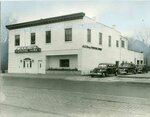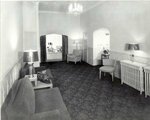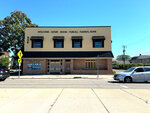


A “for sale” sign is up at the Holcomb-Henry-Boom-Purcell funeral home, 536 N. Snelling Ave. If property use changes under a new owner, that brings an end to more than a century of service in the Midway area. It also would leave just one funeral home in the Monitor’s area.
How people are remembered at their time of passing has changed over the years. Cremation and celebrations of life held at a wide range of venues are commonplace today.
In the 19th century, undertakers or morticians began to assist families. They worked out of storefronts or small offices. Visitations and wakes were often held in private homes or at a place of worship prior to a funeral.
Funeral homes opened their doors in the early 20th century. Many initially catered to specific faith-based or ethnic communities or maintained close ties to congregations. A funeral home might be considered the go-to place for German Lutherans or Italian Catholics.
Two historic funeral homes are Spielman Mortuary at 344 University Ave. W. and Brooks Funeral Home at 862 Concordia Ave. Brooks Funeral Home is one of the nation’s oldest Black-owned and operated funeral homes, dating from 1941. Its current location dates from 1959.
The Spielman Mortuary building has retained much of its original character, opening more than 80 years ago as National Funeral Home. Kenneth and Helen Spielman purchased the business in 1950. They were the longest-term owners, living above the funeral home. They only took one short vacation during more than 30 years ownership.
The first funeral home director at 536 N. Snelling Ave. was Albert E. Henry, assisted by his wife Vena. The Henry family lived upstairs. A centennial history noted that in 1916 the business was unlocked and open 24 hours. Because not everyone had a phone, people might arrive at all hours for help.
Albert Henry retired in 1948. Earl Holcomb and two partners bought the funeral home. Holcomb and his wife Roswitha moved their family upstairs.
Boom was added to the name after funeral director Dennis Boom took over the business. He started working with the Holcombs in 1963 and eventually purchased the business. Richard Purcell joined the business in 1982, and worked his way into ownership.
When the Henrys opened their funeral home in 1916, St. Paul had a few dozen small, family-owned and operated funeral homes throughout its neighborhoods.
One early area business was the Charles H. Mueller Undertaking Parlor, which got its start on University Avenue in Frogtown in 1905. As demand grew for a separate funeral home, Mueller opened a funeral chapel at 575 University Ave. in 1935. That building is gone now.
A company history tells us that Mueller’s son-in-law Albert Bies joined the business during the Great Depression. The Bies family maintains ownership today, continuing a century-old tradition.
Mueller-Bies moved to a larger, new facility at 650 N. Dale St. in 1955. For about a decade Mueller-Bies operated East and West funeral homes on Dale Street. The Steiger-Ecker Funeral Home at 625 N. Dale St. closed and was purchased by Mueller-Bies to be its West Chapel.
Why have two facilities? Uncertainty about Dale Street widening affected businesses and homeowners for many years.
Plans to widen Dale Street took shape in the 1960s. The eight-block section in Frogtown was last to be completed. The St. Paul City Council approved construction in 1988 but the project met many delays. By 1994, four structures remained in the project’s way – a private home, Woodshed Bar, Sportsmen’s Liquors and the Mueller-Bies East Chapel.
The East Chapel was torn down in 1995. The West Chapel was sold and Mueller-Bies focused its operations in Roseville, where it built a new facility in 1985.
The West Chapel became the Hmong Funeral Home, which quickly outgrew its small building. Neighbors were unhappy with traditional services that lasted for days. Hmong families sometimes had to wait weeks if not months to hold services, given demands on the facility.
The city purchased the property in 2008 and tore in down in anticipation of development expected with Green Line light rail. It has been a community garden ever since.
Read a 2016 history of Holcomb-Henry-Boom-Purcell at https://monitorsaintpaul.com/stories/holcomb-henry-boom-purcell-turns-100,696
Comments
No comments on this item Please log in to comment by clicking here